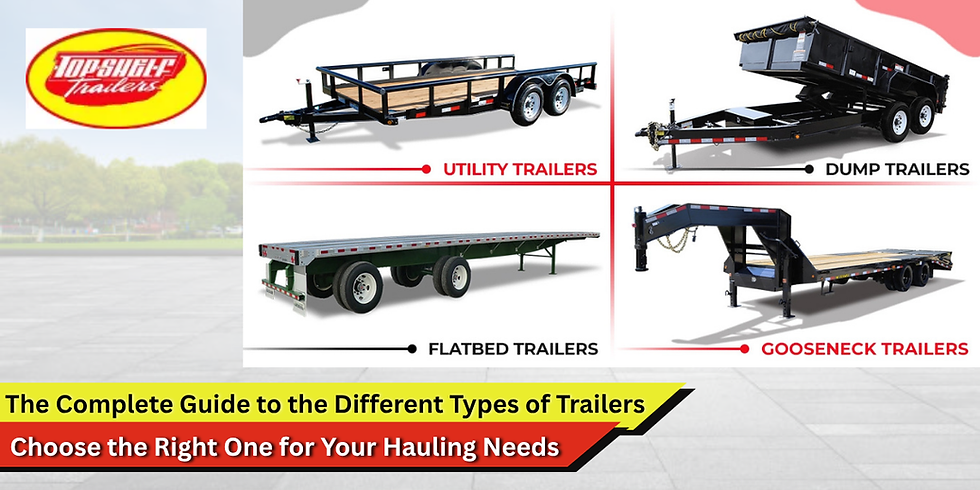The Complete Guide to the Different Types of Trailers: Choose the Right One for Your Hauling Needs
- topshelfdumptraile
- Jun 18
- 3 min read
When it comes to transporting heavy loads, equipment, or materials, choosing the right trailer isn’t just a convenience—it’s a necessity. The right trailer can improve efficiency, enhance safety, and reduce long-term wear and tear. Whether you're moving construction equipment or hauling gravel in a dump trailer, understanding the types of hauling trailers available helps ensure you’re investing in the right tool for the job.
This guide breaks down the most common types of trailers, explores braking systems, and helps you figure out how to choose the right trailer based on your specific needs.

Dump Trailers
Dump trailers are among the most popular and practical hauling solutions. Designed with hydraulic lift systems, they make unloading debris, gravel, or materials quick and efficient. Available in various sizes and weight capacities, dump trailers are ideal for:
• Construction sites
• Landscaping work
• Cleanup crews
• Equipment transport (with a combo gate and ramps)
Their versatility and rugged build make them a top choice for both commercial and personal use. For heavier-duty tasks, consider a dual-cylinder or scissor-lift design for added stability during dumping.
Gooseneck Trailers
Gooseneck trailers are built for stability, strength, and serious hauling. They connect to a ball hitch mounted in the bed of a pickup truck, creating better weight distribution and improved control on the road.
Best for:
• Transporting heavy machinery
• Agricultural use
• Long-distance hauling
• Higher payload requirements
Goosenecks generally offer a tighter turning radius and superior load capacity, making them a favorite among professional haulers.
Bumper-Pull Trailers
Bumper-pull trailers attach to a standard hitch receiver at the back of your vehicle, making them more accessible for everyday drivers. They’re often used for lighter loads and short hauls and are popular among homeowners and small business operators.
Key advantages include:
• Easy to hitch/unhitch
• No need for a special hitch installed in the truck bed
• Great for general utility hauling
While they’re typically smaller than gooseneck options, bumper-pulls are more budget-friendly and work well with a wide variety of tow vehicles.
Equipment Trailers
Equipment trailers are purpose-built for hauling tractors, skid steers, and other machinery. With reinforced decks, ramps, and enhanced tie-down points, these trailers are all about safety and security.
Many equipment trailers also come with adjustable braking systems and LED lighting,
making them compliant with DOT regulations for road travel.
Tilt Trailers
These trailers use a tilting bed to allow easy loading and unloading without ramps. Especially helpful when transporting low-clearance machinery, tilt trailers save time and hassle on job sites.
Perfect for:
• Scissor lifts
• Forklifts
• Compact tractors
• Other wheeled equipment
Tilt trailers are available in both full-tilt and partial-tilt designs, with hydraulic assist for smoother operation.
Trailer Braking Systems: What You Need to Know
No matter the type of trailer, a reliable braking system is a must. Here are the two main types:
1. Electric Brakes
These brakes are powered by the tow vehicle’s electrical system and are controlled through a brake controller mounted in the cab. They're common on most modern trailers, especially dump trailers, goosenecks, and equipment haulers.
Pros:
• Adjustable braking force
• Good control over trailer braking
• Great for heavier loads
2. Surge Brakes
These are hydraulic systems that engage automatically when the towing vehicle slows down. You’ll often find them on lighter or older trailer models.
Pros:
• No need for electric connections
• Self-contained system
• Simpler installation
Make sure to match your trailer’s brake system with your vehicle’s towing capacity and braking controller for optimal safety.
How to Choose the Right Trailer
Selecting the right trailer depends on more than just what you’re hauling. Here’s what to consider:
✅ Payload Capacity
Estimate the weight of the materials, machinery, or vehicles you’ll regularly be towing.
✅ Towing Vehicle
Make sure your truck or SUV has the capacity and hitch system to handle the trailer and load safely.
✅ Frequency of Use
Daily haulers may benefit from investing in high-durability materials and advanced features like hydraulic jacks or LED lighting.
✅ Terrain and Travel Distance
For long highway hauls or rough terrain, choose trailers with enhanced suspension and braking systems.
✅ Legal Requirements
Ensure your trailer setup meets your local Department of Transportation (DOT) regulations.
Final Thoughts
From compact bumper-pull trailers to heavy-duty gooseneck setups and versatile dump trailers, there’s a perfect match for every hauler. The key is understanding your unique requirements and matching them to the right trailer design and braking system. With the right setup, you’ll not only save time and money—you’ll also enjoy safer, smoother towing across every mile.
If you still have questions or need help choosing the right trailer for your needs, feel free to Contact Us directly. Want to know more about the team behind these industry insights? Visit our About Us page to learn more.



Comments